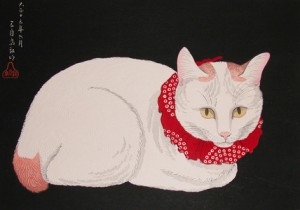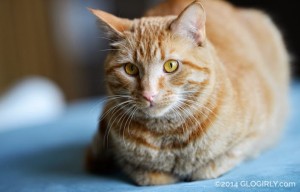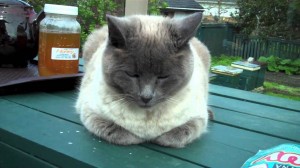I was in a book store and found this lovely postcard. I thought I’d sent it to my equally cat-crazy aunt to say hi.
Artist: TAKAHASHI Shōtei (Hiroaki) 高橋 松亭 (弘明), 1871-1945 (other names are: Kakei, Komei, and Rakutei. )
Format: ōban 大判, 37/38 cm × 25,5 cm
Publisher: Watanabe 渡辺.
Detail of the caption and seals
The publisher’s seal is not shown on most scans of the print found online, and also not on my postcard, it reads „Watanabe“ in Katakana: ワタナベ. It was used in 6mm from 1918-1924, 1945-1957, and in slightly larger form (7mm), posthumous from 1957 onwards.

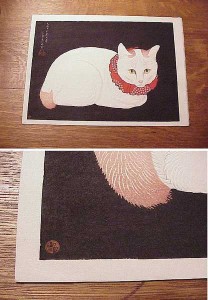
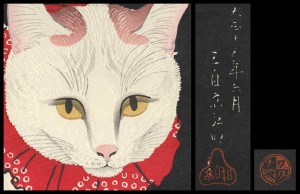
Below the elegant white caption is the seal of the Artist, reading „Shōtei 松亭“ in seal script right to left. List of seals attributed to Shōtei can be found here and here.

The particular one used here is in a triangular shape. Possibly a hand guard for katana swords- the tsuba (鍔 or 鐔), indicated by the curious elongated hole between the charcters 亭 and 松. I’ve never seen a tsuba in such a shape, though. The shape also reminds me of the character for mountain, 山.
My colleague Olaf Schneemann pointed out a tsuba in such curious shape does, in fact, exsist, as the following one. Published in: Gillot, Charles: Objets d’art et peintures d’Extrême-Orient, Galerie Durand-Ruel, Paris: 1904, p. 203, description p. 207, read online
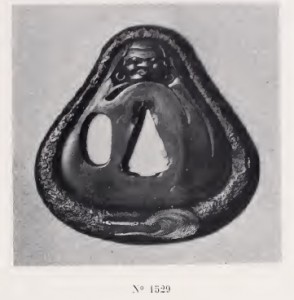
„Garde, fer et bronze, Forme bursaire, avec incrustation d’or et de chibuitchi. Elle figure Dharma accroupi. Par Hamano“
There are also two additional seals, one being the publisher’s seal in Latin/English „Printed by S.Watanabe, Tokio“. The other one gives information about the publisher/ copyright.
Additional seal on the left reads:
版権所有 渡辺庄三郎 Copyright by Watanabe Shōzaburō.
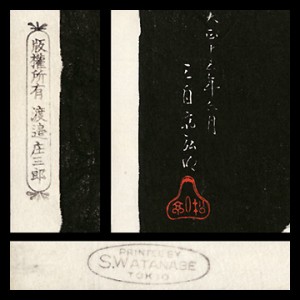
The main caption in white reads:
大正十三年六月 Year: Taishō 13, 6th month. (means: in 1924, 6th month of lunar calendar)
三自 ? ? ?
The second row is too hard to read, maybe because of the scans, or the print edition. I’m clueless what it says at the moment.
Collar
Shōtei’s cat is wearing a ruffled red collar with a white small circle pattern. The cloth pattern is reminiscient of fawn spots (kanoko 鹿子). This design could be archieved in different ways. One would be kinds of resist dying, either with rice paste (tsutsugaki 筒描), or wax resist (rōketsuzome ろうけつ染め). Second option would be the much more difficult japanese tie-dye batik technique, kanoko shibori 鹿子絞り. The kanoko pattern is arranged in big circles, giving the collar a folkloristic touch.
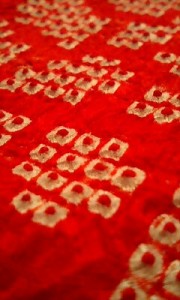
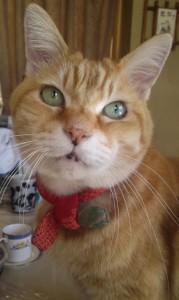
Compare fe. the cat pictures of both famous Edo-masters and cat-lovers Utagawa Kuniyoshi (1798-1861) or Utagawa Hiroshige (1797-1858).
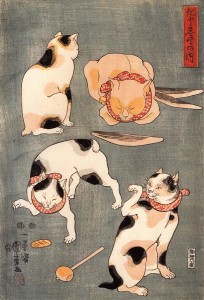
The ukiyo-e by Utwagaw Kuniyoshi „Four cats in different poses“ also shows a meatloaf cat in the upper right corner. Note this one has her eyes closed, and is wearing a red simple tie collar, also showing the kanoko shiburi pattern.
Collaring pets with such a red collar was popular in Edo period. The Shōtei cat wears not such a simple tie collar as the ones shown above, but instead a ruffled red collar. These frilly red collars were also popular decorations for stone lion dogs (foo dogs, komainu 狛犬), and small pet dogs.
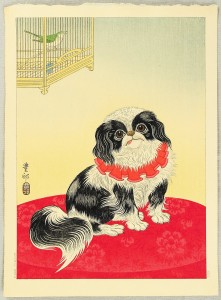
Those remind me of tibetan kekhor collars, made from dyed yak hair to decorate prized dogs.
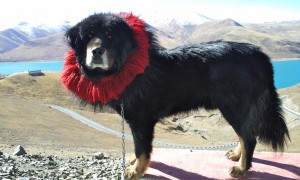
The kekhor might or might not be related to the frilly ruffled collar for pets, maybe through a misinterpretation of the painter/maker. I’m still not sure about that. Either way, the Shōtei cat wears some rather unusual collar type for a cat, whereas the red kanoko shiburi pattern was very popular and common.
Comments on Iconography and Cat Physiognomy
The cat’s name is sometimes given as „Tama“ but honestly I don’t know where that comes from. It is a portrait of a japanese bobtail cat (ボブテイル), also known as Kazoku-neko 家族猫 („Family cat“). Those cats are not crippled but rather bred with the iconic short tail since Edo period (1603–1867). White coat fur is very popular, often calico, too.
The cat shown is mainly white with a red mask, red tail, and yellow eyes. The position she sits in is sometimes called „meatloaf“ or „catloaf“. It is a position a cat takes when being content and relaxed in her surroundings, as the position is not enforcing suddenly getting up or clawing at things. The „meatloaf“ is also great for keeping warm by tucking in extremities. None of her paws is visible. Usually, cats in the „meatloaf“ soon close their eyes (full or half), in a sleepy, relaxed way. The portayed cat on the other hand, looks curiously and friendly with a slightly bowed head at the viewer. This is indicated by the shadows on her heyes, her small pupils, and ears pointing like a radar in different directions. The asymmetrical ear position is cat body language for playfulness, but also curiosity- she seems to be reacting to some sudden sound. One could even go as far to say that she also seems to be smiling in a cartoonish way, as it is often common with the distinct shape of cat’s cheeks, giving the mouth an upward curve.
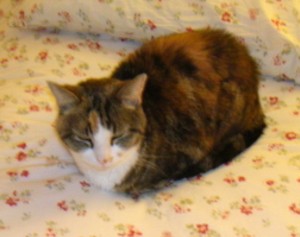
As the background is solid black, she is floating without an horizon. I’d imagine the horizon just below her neckline as indicated by lightning and small shadows on her fur. The viewer would be crouching with her this way, maybe sitting together on the floor and calling her name or whistling to attract her attention. With the slight bow of the head, her relaxed body language, and the imagined „smile“, she seems to be responding to a friendly greeting as in human interaction, making acquaintances.
